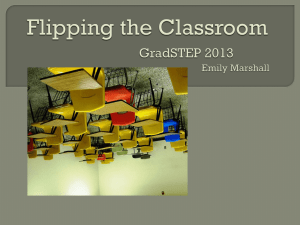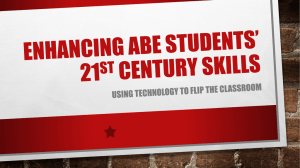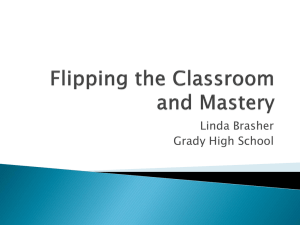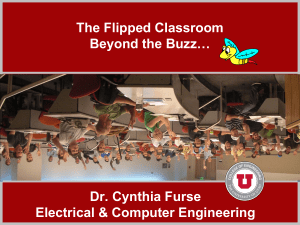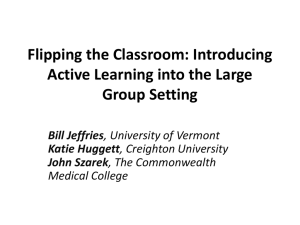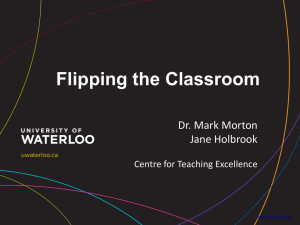Flipped Classroom Presentation – 6th Nov 2013
advertisement
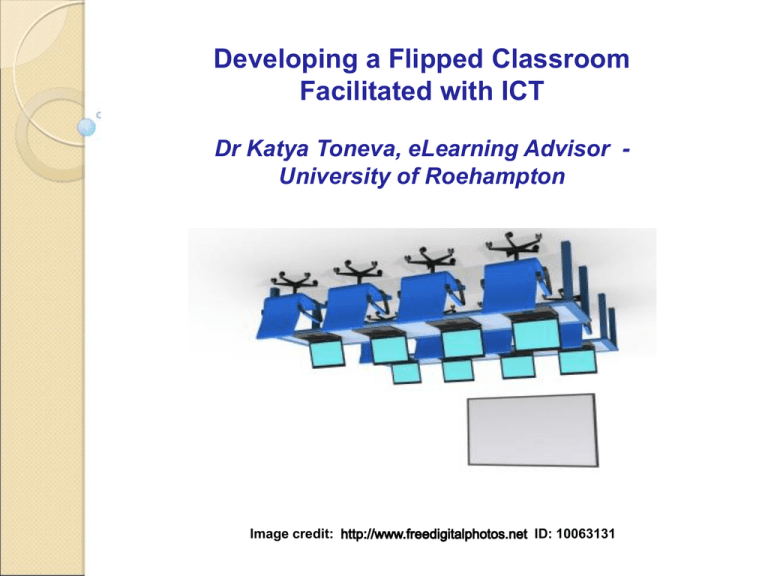
Developing a Flipped Classroom Facilitated with ICT Dr Katya Toneva, eLearning Advisor University of Roehampton Image credit: ID: 10063131 What is the Flipped Classroom? The use of a reversed teaching model that delivers the content and instruction at home through interactive videos and other learning resources, and moves homework to the classroom. Image credit: ID: 100159199 Flipping Puts Students at the Centre – Two Case Studies from the International Community School, London (www.icschool.co.uk) Start small (flip one or two lessons) - Choose your own balance of lessons and activities – Use your existing material and create videos – Students like watching videos on their own devices (laptops, tablets, smart phones, etc.) – Share your case studies online Case Study 1 (2011-12) – in Mathematics – The teacher prerecorded video materials illustrating and explaining complex concepts that students were required to study at home. In class, the students were given the opportunity to complete specific exercises reflecting on the materials studied at home, to develop discussions, and to receive help from the teacher and peers. Case Study 2 – in English (a cross-school project called “FlatClassroom”): Flat Classroom Project (FCP) Dr Katya Toneva (ICT Director and Project Manager) Sarwat Siddiqui (Leading Teacher) International Community School, London: www.icschool.co.uk September-December 2011 Flat Classroom Project During the first term of 2011/12 academic year, the International Community School, London took part in the global Flat Classroom Project that uses web 2.0 technology to join-up students from around the world. The idea being to “flatten” the classroom walls so students can communicate and work with their peers online, across the world. The school took part in the project on a particular topic: “How ICT could improve people’s lives”. This was linked to the English curriculum. The idea was that students could develop their English language proficiency and academic language skills through researching, collecting, analysing, evaluating, reporting and presenting information via the virtual Flat Classroom. The required final product was a video storyboard on the project topic. Why consider the potential of innovative technologies that support language development and collaborative learning? • New technologies can be powerful tools for using and acquiring language skills. • The nature of work is changing. • We need to prepare our students to compete in a new global economy. • We need to prepare our students to be effective 21st Century citizens. Our FCP aims: ■ Transform the learning environment into an inspirational learning space where students interact, create, collaborate and build up knowledge whilst using language for these different purposes. ■ Develop students’ skills of cooperation, communication, collaboration and competition, and their use of topic vocabulary. ■ Introduce our students to global communities with similar interests and provide the opportunity for them to communicate and collaborate. I Using integrated Web 2.0 technologies to facilitate the flipping learning The teacher required from the students to research the content at home and used her class as a place where students carried out meaningful activities instead of listening to “a lecture”. The teacher used the lesson time to guide students in their learning instead of being the authoritative “instructor”. For example, the students needed to contribute to wiki spaces to introduce themselves and to plan their projects. They needed to use Flatclassroom Ning space, online forums and Google docs to share examples, to communicate with other Flatclassroom students across the world and to provide peer support and feedback. Students used Animoto and YouTube to edit and publish their video storyboards. They used Elluminate webconferencing software to present their final products. ICS FCP Students: TomaB ICS IsZ ICS AlixS ICS BgI ICS GabyL ICS AtN ICS The teacher’s and students’ comments on the project development are available on the . Links to ICS students’ final work are published at the For example, please watch a student’s . The Flipped Classroom Approach and 21st Century Learning Skills Our “flipped classroom” approach promotes the shift of the ownership of learning from the teachers to the students. The “flipped classroom” encourages learning through activity and enhances the interactions teacher-student-teacher and studentstudent. The students needed to understand the principles of working online and to adopt new skills and behaviours, including skills for online communication, collaboration and networking – these are core 21st Century learning skills. Flipped Classroom – Pros and Cons (Summary) Pros: •Create a collaborative learning environment. •Build sound student-teacher relationships. •Allow students to reflect on your videos and other learning resources. •Share information with other departments, teachers, students, and parents. •Build an online library of video lectures and other learning resources for students to review anytime, anywhere. Cons: • Not everyone learns best through a screen. • Disadvantage for students who have not the Internet access at home. • Teachers need to invest extra time to create video and other learning resources and make these available online. However, do teachers really need to do this? – Let’s see what one experienced teacher thinks about the Flipped Classroom approach: Getting Started with the Flipped Classroom 1. The Flipped Classroom Network: 2. The Flipped High School: 3. Flipped Teaching: 4. The Flipped Learning Network: 5. Khan Academy: / Useful Tools: FREE: 1. - records your screen 2 is a good resource for storing your videos on the web. 3. Editing . 4. Screenshots: check out COST: 1 (PC & Mac) A full suite of professional tools that records your screen and turns PowerPoint into video. 2 (Mac only) Publish directly to YouTube. Thank you for your interest! For contacts: Email: Image credit: •
